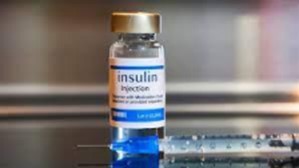A nurse is caring for an adolescent client who has a long history of diabetes mellitus and is being admitted to the emergency department confused, flushed, and with an acetone odor on the breath. Diabetic ketoacidosis is suspected. The nurse should anticipate using which of the following types of insulin to treat this client?

NPH insulin
Insulin glargine
Insulin detemir
Regular Insulin
The Correct Answer is D
A. NPH insulin: NPH insulin, also known as Neutral Protamine Hagedorn, is an intermediate acting insulin. It has a slower onset of action and a longer duration compared to regular insulin. It is not the best choice for treating diabetic ketoacidosis (DKA) because it does not act quickly enough to lower dangerously high blood glucose levels in this acute situation.
B. Insulin glargine: Insulin glargine is a long-acting basal insulin. It has a slow, steady release and provides a consistent level of insulin over an extended period. Like NPH insulin, it is not suitable for rapidly lowering blood glucose levels in a DKA emergency.
C. Insulin detemir: Insulin detemir is another long-acting basal insulin similar to glargine. It has a slow onset and provides a sustained release of insulin. It is not the first-line choice for treating DKA due to its slower action.
D. Regular Insulin: Regular insulin, also known as short-acting or fast-acting insulin, has a rapid onset of action. When administered intravenously, it can quickly lower blood glucose levels. This makes it the preferred choice for treating diabetic ketoacidosis (DKA) where prompt action is essential to correct the severe hyperglycemia and associated metabolic imbalances.
Nursing Test Bank
Naxlex Comprehensive Predictor Exams
Related Questions
Correct Answer is A
Explanation
1 AM while sleeping: NPH insulin, like Humulin N, typically reaches its peak effectiveness about 4-12 hours after administration. Since the client takes it at 5 PM, the time of greatest risk for hypoglycemia is around 1 AM when the insulin's effects are at their peak. This is a critical period for monitoring blood glucose levels.
B. 8 PM shortly after dinner: By 8 PM, the NPH insulin's effectiveness is not at its peak. It's been about 3 hours since administration, and the insulin is still working to lower blood glucose levels. This time frame is not associated with the highest risk of hypoglycemia.
C. 6 PM shortly after dinner: At 6 PM, it's been only about an hour since the client took the NPH insulin. The insulin is just beginning to take effect, and the risk of hypoglycemia is not as high as it would be later in the night.
D. 11:00 AM, shortly before lunch: By 11:00 AM, the effects of the NPH insulin from the previous evening have largely worn off. This time frame is not associated with a high risk of hypoglycemia related to the evening dose of NPH insulin.
Correct Answer is ["B","C","D","E"]
Explanation
A. Incorrect. Sustaining hyperglycemia is not a recommended approach. In fact, it is crucial to maintain blood glucose levels within a target range to prevent complications associated with diabetes.
B. Correct. Maintaining optimal blood pressure is important for preventing kidney damage, which is a common complication of diabetes. High blood pressure can exacerbate kidney problems in individuals with diabetes.
C. Correct. Reducing cholesterol and saturated fat intake is important for managing cardiovascular risk factors associated with diabetes. Elevated cholesterol levels are a risk factor for heart disease, which is more prevalent in individuals with diabetes.
D. Correct. Enrolling in a smoking cessation program is essential. Smoking increases the risk of cardiovascular disease, which is already elevated in individuals with diabetes. Quitting smoking is a crucial step in reducing this risk.
E. Correct. Increasing physical activity is an important component of diabetes management. Regular exercise helps improve insulin sensitivity, maintain a healthy weight, and reduce the risk of cardiovascular complications.
Whether you are a student looking to ace your exams or a practicing nurse seeking to enhance your expertise , our nursing education contents will empower you with the confidence and competence to make a difference in the lives of patients and become a respected leader in the healthcare field.
Visit Naxlex, invest in your future and unlock endless possibilities with our unparalleled nursing education contents today
Report Wrong Answer on the Current Question
Do you disagree with the answer? If yes, what is your expected answer? Explain.
Kindly be descriptive with the issue you are facing.
